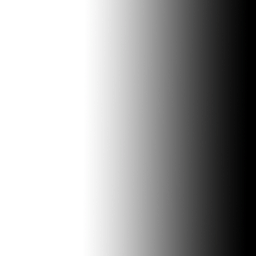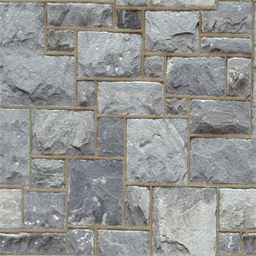DirectX 10 教程19:Alpha映射
原文地址:Tutorial 19: Alpha Mapping(http://www.rastertek.com/dx10tut19.html)。
源代码下载:dx10tut19.zip。
Alpha映射指在组合两张纹理时,使用一张alpha贴图确定每个像素的混合权重。
首先需要创建一个如下图所示的alpha贴图:

每个像素的范围在0.0和1.0之间,表示如何组合两张纹理。例如如果一个像素的alpha值为0.3,则取30%的基纹理像素值和70%的颜色纹理像素值进行组合。本教程会组合以下两张纹理:


最终的结果如下图所示:

本教程我们将alpha贴图放置在一张独立的纹理中,这样我们就可以使用不同的alpha贴图组合相同的两张纹理。
本教程的代码基于上一个教程。
Alphamap.fx
alpha map shader只是上一个教程的light map shader的改编版本。
//////////////////////////////////////////////////////////////////////////////// // Filename: alphamap.fx //////////////////////////////////////////////////////////////////////////////// ///////////// // GLOBALS // ///////////// matrix worldMatrix; matrix viewMatrix; matrix projectionMatrix;
第一个改变是纹理数组包含第三个元素用于保存alpha贴图。
Texture2D shaderTextures[3];
///////////////////
// SAMPLE STATES //
///////////////////
SamplerState SampleType
{
Filter = MIN_MAG_MIP_LINEAR;
AddressU = Wrap;
AddressV = Wrap;
};
//////////////
// TYPEDEFS //
//////////////
struct VertexInputType
{
float4 position : POSITION;
float2 tex : TEXCOORD0;
};
struct PixelInputType
{
float4 position : SV_POSITION;
float2 tex : TEXCOORD0;
};
////////////////////////////////////////////////////////////////////////////////
// Vertex Shader
////////////////////////////////////////////////////////////////////////////////
PixelInputType AlphaMapVertexShader(VertexInputType input)
{
PixelInputType output;
// Change the position vector to be 4 units for proper matrix calculations.
input.position.w = 1.0f;
// Calculate the position of the vertex against the world, view, and projection matrices.
output.position = mul(input.position, worldMatrix);
output.position = mul(output.position, viewMatrix);
output.position = mul(output.position, projectionMatrix);
// Store the texture coordinates for the pixel shader.
output.tex = input.tex;
return output;
}
主要的变化在像素着色器之中。首先采样三张纹理,然后将alpha值乘以基纹理像素颜色,(1.0 - alpha)乘以第二张纹理像素颜色,最后相加获取最终的像素颜色。
////////////////////////////////////////////////////////////////////////////////
// Pixel Shader
////////////////////////////////////////////////////////////////////////////////
float4 AlphaMapPixelShader(PixelInputType input) : SV_Target
{
float4 color1;
float4 color2;
float4 alphaValue;
float4 blendColor;
// Get the pixel color from the first texture.
color1 = shaderTextures[0].Sample(SampleType, input.tex);
// Get the pixel color from the second texture.
color2 = shaderTextures[1].Sample(SampleType, input.tex);
// Get the alpha value from the alpha map texture.
alphaValue = shaderTextures[2].Sample(SampleType, input.tex);
// Combine the two textures based on the alpha value.
blendColor = (alphaValue * color1) + ((1.0 - alphaValue) * color2);
// Saturate the final color value.
blendColor = saturate(blendColor);
return blendColor;
}
////////////////////////////////////////////////////////////////////////////////
// Technique
////////////////////////////////////////////////////////////////////////////////
technique10 AlphaMapTechnique
{
pass pass0
{
SetVertexShader(CompileShader(vs_4_0, AlphaMapVertexShader()));
SetPixelShader(CompileShader(ps_4_0, AlphaMapPixelShader()));
SetGeometryShader(NULL);
}
}
Alphamapshaderclass.h
AlphaMapShaderClass只在上一个教程中的LightMapShaderClass上稍加修改。
////////////////////////////////////////////////////////////////////////////////
// Filename: alphamapshaderclass.h
////////////////////////////////////////////////////////////////////////////////
#ifndef _ALPHAMAPSHADERCLASS_H_
#define _ALPHAMAPSHADERCLASS_H_
//////////////
// INCLUDES //
//////////////
#include <d3d10.h>
#include <d3dx10.h>
#include <fstream>
using namespace std;
////////////////////////////////////////////////////////////////////////////////
// Class name: AlphaMapShaderClass
////////////////////////////////////////////////////////////////////////////////
class AlphaMapShaderClass
{
public:
AlphaMapShaderClass();
AlphaMapShaderClass(const AlphaMapShaderClass&);
~AlphaMapShaderClass();
bool Initialize(ID3D10Device*, HWND);
void Shutdown();
void Render(ID3D10Device*, int, D3DXMATRIX, D3DXMATRIX, D3DXMATRIX, ID3D10ShaderResourceView**);
private:
bool InitializeShader(ID3D10Device*, HWND, WCHAR*);
void ShutdownShader();
void OutputShaderErrorMessage(ID3D10Blob*, HWND, WCHAR*);
void SetShaderParameters(D3DXMATRIX, D3DXMATRIX, D3DXMATRIX, ID3D10ShaderResourceView**);
void RenderShader(ID3D10Device*, int);
private:
ID3D10Effect* m_effect;
ID3D10EffectTechnique* m_technique;
ID3D10InputLayout* m_layout;
ID3D10EffectMatrixVariable* m_worldMatrixPtr;
ID3D10EffectMatrixVariable* m_viewMatrixPtr;
ID3D10EffectMatrixVariable* m_projectionMatrixPtr;
ID3D10EffectShaderResourceVariable* m_textureArrayPtr;
};
#endif
Alphamapshaderclass.cpp
////////////////////////////////////////////////////////////////////////////////
// Filename: alphamapshaderclass.cpp
////////////////////////////////////////////////////////////////////////////////
#include "alphamapshaderclass.h"
AlphaMapShaderClass::AlphaMapShaderClass()
{
m_effect = 0;
m_technique = 0;
m_layout = 0;
m_worldMatrixPtr = 0;
m_viewMatrixPtr = 0;
m_projectionMatrixPtr = 0;
m_textureArrayPtr = 0;
}
AlphaMapShaderClass::AlphaMapShaderClass(const AlphaMapShaderClass& other)
{
}
AlphaMapShaderClass::~AlphaMapShaderClass()
{
}
bool AlphaMapShaderClass::Initialize(ID3D10Device* device, HWND hwnd)
{
bool result;
第一个变化在于加载的是alphamap.fx HLSL shader文件。
// Initialize the shader that will be used to draw the model.
result = InitializeShader(device, hwnd, L"../Engine/alphamap.fx");
if(!result)
{
return false;
}
return true;
}
void AlphaMapShaderClass::Shutdown()
{
// Shutdown the shader effect.
ShutdownShader();
return;
}
void AlphaMapShaderClass::Render(ID3D10Device* device, int indexCount, D3DXMATRIX worldMatrix, D3DXMATRIX viewMatrix,
D3DXMATRIX projectionMatrix, ID3D10ShaderResourceView** textureArray)
{
// Set the shader parameters that it will use for rendering.
SetShaderParameters(worldMatrix, viewMatrix, projectionMatrix, textureArray);
// Now render the prepared buffers with the shader.
RenderShader(device, indexCount);
return;
}
bool AlphaMapShaderClass::InitializeShader(ID3D10Device* device, HWND hwnd, WCHAR* filename)
{
HRESULT result;
ID3D10Blob* errorMessage;
D3D10_INPUT_ELEMENT_DESC polygonLayout[2];
unsigned int numElements;
D3D10_PASS_DESC passDesc;
// Initialize the error message.
errorMessage = 0;
// Load the shader in from the file.
result = D3DX10CreateEffectFromFile(filename, NULL, NULL, "fx_4_0", D3D10_SHADER_ENABLE_STRICTNESS, 0,
device, NULL, NULL, &m_effect, &errorMessage, NULL);
if(FAILED(result))
{
// If the shader failed to compile it should have writen something to the error message.
if(errorMessage)
{
OutputShaderErrorMessage(errorMessage, hwnd, filename);
}
// If there was nothing in the error message then it simply could not find the shader file itself.
else
{
MessageBox(hwnd, filename, L"Missing Shader File", MB_OK);
}
return false;
}
Technique名称变为AlphaMapTechnique。
// Get a pointer to the technique inside the shader.
m_technique = m_effect->GetTechniqueByName("AlphaMapTechnique");
if(!m_technique)
{
return false;
}
// Now setup the layout of the data that goes into the shader.
// This setup needs to match the VertexType stucture in the ModelClass and in the shader.
polygonLayout[0].SemanticName = "POSITION";
polygonLayout[0].SemanticIndex = 0;
polygonLayout[0].Format = DXGI_FORMAT_R32G32B32_FLOAT;
polygonLayout[0].InputSlot = 0;
polygonLayout[0].AlignedByteOffset = 0;
polygonLayout[0].InputSlotClass = D3D10_INPUT_PER_VERTEX_DATA;
polygonLayout[0].InstanceDataStepRate = 0;
polygonLayout[1].SemanticName = "TEXCOORD";
polygonLayout[1].SemanticIndex = 0;
polygonLayout[1].Format = DXGI_FORMAT_R32G32_FLOAT;
polygonLayout[1].InputSlot = 0;
polygonLayout[1].AlignedByteOffset = D3D10_APPEND_ALIGNED_ELEMENT;
polygonLayout[1].InputSlotClass = D3D10_INPUT_PER_VERTEX_DATA;
polygonLayout[1].InstanceDataStepRate = 0;
// Get a count of the elements in the layout.
numElements = sizeof(polygonLayout) / sizeof(polygonLayout[0]);
// Get the description of the first pass described in the shader technique.
m_technique->GetPassByIndex(0)->GetDesc(&passDesc);
// Create the input layout.
result = device->CreateInputLayout(polygonLayout, numElements, passDesc.pIAInputSignature, passDesc.IAInputSignatureSize,
&m_layout);
if(FAILED(result))
{
return false;
}
// Get pointers to the three matrices inside the shader so we can update them from this class.
m_worldMatrixPtr = m_effect->GetVariableByName("worldMatrix")->AsMatrix();
m_viewMatrixPtr = m_effect->GetVariableByName("viewMatrix")->AsMatrix();
m_projectionMatrixPtr = m_effect->GetVariableByName("projectionMatrix")->AsMatrix();
// Get pointer to the texture array resource inside the shader.
m_textureArrayPtr = m_effect->GetVariableByName("shaderTextures")->AsShaderResource();
return true;
}
void AlphaMapShaderClass::ShutdownShader()
{
// Release the pointer to the texture in the shader file.
m_textureArrayPtr = 0;
// Release the pointers to the matrices inside the shader.
m_worldMatrixPtr = 0;
m_viewMatrixPtr = 0;
m_projectionMatrixPtr = 0;
// Release the pointer to the shader layout.
if(m_layout)
{
m_layout->Release();
m_layout = 0;
}
// Release the pointer to the shader technique.
m_technique = 0;
// Release the pointer to the shader.
if(m_effect)
{
m_effect->Release();
m_effect = 0;
}
return;
}
void AlphaMapShaderClass::OutputShaderErrorMessage(ID3D10Blob* errorMessage, HWND hwnd, WCHAR* shaderFilename)
{
char* compileErrors;
unsigned long bufferSize, i;
ofstream fout;
// Get a pointer to the error message text buffer.
compileErrors = (char*)(errorMessage->GetBufferPointer());
// Get the length of the message.
bufferSize = errorMessage->GetBufferSize();
// Open a file to write the error message to.
fout.open("shader-error.txt");
// Write out the error message.
for(i=0; i<bufferSize; i++)
{
fout << compileErrors[i];
}
// Close the file.
fout.close();
// Release the error message.
errorMessage->Release();
errorMessage = 0;
// Pop a message up on the screen to notify the user to check the text file for compile errors.
MessageBox(hwnd, L"Error compiling shader. Check shader-error.txt for message.", shaderFilename, MB_OK);
return;
}
void AlphaMapShaderClass::SetShaderParameters(D3DXMATRIX worldMatrix, D3DXMATRIX viewMatrix, D3DXMATRIX projectionMatrix,
ID3D10ShaderResourceView** textureArray)
{
// Set the world matrix variable inside the shader.
m_worldMatrixPtr->SetMatrix((float*)&worldMatrix);
// Set the view matrix variable inside the shader.
m_viewMatrixPtr->SetMatrix((float*)&viewMatrix);
// Set the projection matrix variable inside the shader.
m_projectionMatrixPtr->SetMatrix((float*)&projectionMatrix);
第三个变化是设置的是三张纹理而不是上一个教程的两个。
// Bind the texture array.
m_textureArrayPtr->SetResourceArray(textureArray, 0, 3);
return;
}
void AlphaMapShaderClass::RenderShader(ID3D10Device* device, int indexCount)
{
D3D10_TECHNIQUE_DESC techniqueDesc;
unsigned int i;
// Set the input layout.
device->IASetInputLayout(m_layout);
// Get the description structure of the technique from inside the shader so it can be used for rendering.
m_technique->GetDesc(&techniqueDesc);
// Go through each pass in the technique (should be just one currently) and render the triangles.
for(i=0; i<techniqueDesc.Passes; ++i)
{
m_technique->GetPassByIndex(i)->Apply(0);
device->DrawIndexed(indexCount, 0, 0);
}
return;
}
Texturearrayclass.h
TextureArrayClass修改为可以处理三张纹理。
////////////////////////////////////////////////////////////////////////////////
// Filename: texturearrayclass.h
////////////////////////////////////////////////////////////////////////////////
#ifndef _TEXTUREARRAYCLASS_H_
#define _TEXTUREARRAYCLASS_H_
//////////////
// INCLUDES //
//////////////
#include <d3d10.h>
#include <d3dx10.h>
////////////////////////////////////////////////////////////////////////////////
// Class name: TextureArrayClass
////////////////////////////////////////////////////////////////////////////////
class TextureArrayClass
{
public:
TextureArrayClass();
TextureArrayClass(const TextureArrayClass&);
~TextureArrayClass();
bool Initialize(ID3D10Device*, WCHAR*, WCHAR*, WCHAR*);
void Shutdown();
ID3D10ShaderResourceView** GetTextureArray();
private:
纹理数组的大小修改为3。
ID3D10ShaderResourceView* m_textures[3]; }; #endif
Texturearrayclass.cpp
//////////////////////////////////////////////////////////////////////////////// // Filename: texturearrayclass.cpp //////////////////////////////////////////////////////////////////////////////// #include "texturearrayclass.h"
构造函数中将三张纹理初始化为null。
TextureArrayClass::TextureArrayClass()
{
m_textures[0] = 0;
m_textures[1] = 0;
m_textures[2] = 0;
}
TextureArrayClass::TextureArrayClass(const TextureArrayClass& other)
{
}
TextureArrayClass::~TextureArrayClass()
{
}
在Initialize方法中将三张纹理加载到纹理数组中。
bool TextureArrayClass::Initialize(ID3D10Device* device, WCHAR* filename1, WCHAR* filename2, WCHAR* filename3)
{
HRESULT result;
// Load the first texture in.
result = D3DX10CreateShaderResourceViewFromFile(device, filename1, NULL, NULL, &m_textures[0], NULL);
if(FAILED(result))
{
return false;
}
// Load the second texture in.
result = D3DX10CreateShaderResourceViewFromFile(device, filename2, NULL, NULL, &m_textures[1], NULL);
if(FAILED(result))
{
return false;
}
// Load the third texture in.
result = D3DX10CreateShaderResourceViewFromFile(device, filename3, NULL, NULL, &m_textures[2], NULL);
if(FAILED(result))
{
return false;
}
return true;
}
Shutdown方法释放三张纹理。
void TextureArrayClass::Shutdown()
{
// Release the texture resources.
if(m_textures[0])
{
m_textures[0]->Release();
m_textures[0] = 0;
}
if(m_textures[1])
{
m_textures[1]->Release();
m_textures[1] = 0;
}
if(m_textures[2])
{
m_textures[2]->Release();
m_textures[2] = 0;
}
return;
}
ID3D10ShaderResourceView** TextureArrayClass::GetTextureArray()
{
return m_textures;
}
Modelclass.h
ModelClass修改为可以处理三张纹理而不是上一个教程的两张。
////////////////////////////////////////////////////////////////////////////////
// Filename: modelclass.h
////////////////////////////////////////////////////////////////////////////////
#ifndef _MODELCLASS_H_
#define _MODELCLASS_H_
//////////////
// INCLUDES //
//////////////
#include <fstream>
using namespace std;
///////////////////////
// MY CLASS INCLUDES //
///////////////////////
#include "texturearrayclass.h"
////////////////////////////////////////////////////////////////////////////////
// Class name: ModelClass
////////////////////////////////////////////////////////////////////////////////
class ModelClass
{
private:
struct VertexType
{
D3DXVECTOR3 position;
D3DXVECTOR2 texture;
};
struct ModelType
{
float x, y, z;
float tu, tv;
float nx, ny, nz;
};
public:
ModelClass();
ModelClass(const ModelClass&);
~ModelClass();
bool Initialize(ID3D10Device*, char*, WCHAR*, WCHAR*, WCHAR*);
void Shutdown();
void Render(ID3D10Device*);
int GetIndexCount();
ID3D10ShaderResourceView** GetTextureArray();
private:
bool InitializeBuffers(ID3D10Device*);
void ShutdownBuffers();
void RenderBuffers(ID3D10Device*);
bool LoadTextures(ID3D10Device*, WCHAR*, WCHAR*, WCHAR*);
void ReleaseTextures();
bool LoadModel(char*);
void ReleaseModel();
private:
ID3D10Buffer *m_vertexBuffer, *m_indexBuffer;
int m_vertexCount, m_indexCount;
ModelType* m_model;
TextureArrayClass* m_TextureArray;
};
#endif
Modelclass.cpp
下面的代码只包含与上一个教程不同的部分。
//////////////////////////////////////////////////////////////////////////////// // Filename: modelclass.cpp //////////////////////////////////////////////////////////////////////////////// #include "modelclass.h"
Initialize方法的参数为三张纹理文件的名称,前两个为颜色纹理,第三个为alpha贴图纹理。
bool ModelClass::Initialize(ID3D10Device* device, char* modelFilename, WCHAR* textureFilename1, WCHAR* textureFilename2,
WCHAR* textureFilename3)
{
bool result;
// Load in the model data.
result = LoadModel(modelFilename);
if(!result)
{
return false;
}
// Initialize the vertex and index buffer that hold the geometry for the triangle.
result = InitializeBuffers(device);
if(!result)
{
return false;
}
LoadTextures的参数现在变为三张纹理的文件名称。
// Load the textures for this model.
result = LoadTextures(device, textureFilename1, textureFilename2, textureFilename3);
if(!result)
{
return false;
}
return true;
}
LoadTextures方法的参数为三张纹理文明的名称,然后创建并加载纹理数组。
bool ModelClass::LoadTextures(ID3D10Device* device, WCHAR* filename1, WCHAR* filename2, WCHAR* filename3)
{
bool result;
// Create the texture array object.
m_TextureArray = new TextureArrayClass;
if(!m_TextureArray)
{
return false;
}
// Initialize the texture array object.
result = m_TextureArray->Initialize(device, filename1, filename2, filename3);
if(!result)
{
return false;
}
return true;
}
Graphicsclass.h
//////////////////////////////////////////////////////////////////////////////// // Filename: graphicsclass.h //////////////////////////////////////////////////////////////////////////////// #ifndef _GRAPHICSCLASS_H_ #define _GRAPHICSCLASS_H_ ///////////// // GLOBALS // ///////////// const bool FULL_SCREEN = true; const bool VSYNC_ENABLED = true; const float SCREEN_DEPTH = 1000.0f; const float SCREEN_NEAR = 0.1f; /////////////////////// // MY CLASS INCLUDES // /////////////////////// #include "d3dclass.h" #include "cameraclass.h" #include "modelclass.h"
新的AlphaMapShaderClass头文件包含在GraphicsClass中。
#include "alphamapshaderclass.h"
////////////////////////////////////////////////////////////////////////////////
// Class name: GraphicsClass
////////////////////////////////////////////////////////////////////////////////
class GraphicsClass
{
public:
GraphicsClass();
GraphicsClass(const GraphicsClass&);
~GraphicsClass();
bool Initialize(int, int, HWND);
void Shutdown();
bool Frame();
bool Render();
private:
D3DClass* m_D3D;
CameraClass* m_Camera;
ModelClass* m_Model;
下面的代码创建新的AlphaMapShaderClass对象。
AlphaMapShaderClass* m_AlphaMapShader; }; #endif
Graphicsclass.cpp
下面的代码只包含与上一个教程不同的部分。
////////////////////////////////////////////////////////////////////////////////
// Filename: graphicsclass.cpp
////////////////////////////////////////////////////////////////////////////////
#include "graphicsclass.h"
GraphicsClass::GraphicsClass()
{
m_D3D = 0;
m_Camera = 0;
m_Model = 0;
在构造函数中将新AlphaMapShaderClass对象初始化为null。
m_AlphaMapShader = 0;
}
GraphicsClass::GraphicsClass(const GraphicsClass& other)
{
}
GraphicsClass::~GraphicsClass()
{
}
bool GraphicsClass::Initialize(int screenWidth, int screenHeight, HWND hwnd)
{
bool result;
D3DXMATRIX baseViewMatrix;
// Create the Direct3D object.
m_D3D = new D3DClass;
if(!m_D3D)
{
return false;
}
// Initialize the Direct3D object.
result = m_D3D->Initialize(screenWidth, screenHeight, VSYNC_ENABLED, hwnd, FULL_SCREEN, SCREEN_DEPTH, SCREEN_NEAR);
if(!result)
{
MessageBox(hwnd, L"Could not initialize Direct3D.", L"Error", MB_OK);
return false;
}
// Create the camera object.
m_Camera = new CameraClass;
if(!m_Camera)
{
return false;
}
// Initialize a base view matrix with the camera for 2D user interface rendering.
m_Camera->SetPosition(0.0f, 0.0f, -1.0f);
m_Camera->Render();
m_Camera->GetViewMatrix(baseViewMatrix);
// Create the model object.
m_Model = new ModelClass;
if(!m_Model)
{
return false;
}
ModelClass对象初始化三张纹理。
// Initialize the model object.
result = m_Model->Initialize(m_D3D->GetDevice(), "../Engine/data/square.txt", L"../Engine/data/stone01.dds",
L"../Engine/data/dirt01.dds", L"../Engine/data/alpha01.dds");
if(!result)
{
MessageBox(hwnd, L"Could not initialize the model object.", L"Error", MB_OK);
return false;
}
下面的代码创建并初始化AlphaMapShaderClass对象。
// Create the alpha map shader object.
m_AlphaMapShader = new AlphaMapShaderClass;
if(!m_AlphaMapShader)
{
return false;
}
// Initialize the alpha map shader object.
result = m_AlphaMapShader->Initialize(m_D3D->GetDevice(), hwnd);
if(!result)
{
MessageBox(hwnd, L"Could not initialize the alpha map shader object.", L"Error", MB_OK);
return false;
}
return true;
}
void GraphicsClass::Shutdown()
{
释放AlphaMapShaderClass对象。
// Release the alpha map shader object.
if(m_AlphaMapShader)
{
m_AlphaMapShader->Shutdown();
delete m_AlphaMapShader;
m_AlphaMapShader = 0;
}
// Release the model object.
if(m_Model)
{
m_Model->Shutdown();
delete m_Model;
m_Model = 0;
}
// Release the camera object.
if(m_Camera)
{
delete m_Camera;
m_Camera = 0;
}
// Release the Direct3D object.
if(m_D3D)
{
m_D3D->Shutdown();
delete m_D3D;
m_D3D = 0;
}
return;
}
bool GraphicsClass::Frame()
{
// Set the position of the camera.
m_Camera->SetPosition(0.0f, 0.0f, -5.0f);
return true;
}
bool GraphicsClass::Render()
{
D3DXMATRIX worldMatrix, viewMatrix, projectionMatrix, orthoMatrix;
// Clear the buffers to begin the scene.
m_D3D->BeginScene(0.0f, 0.0f, 0.0f, 1.0f);
// Generate the view matrix based on the camera's position.
m_Camera->Render();
// Get the world, view, projection, and ortho matrices from the camera and d3d objects.
m_D3D->GetWorldMatrix(worldMatrix);
m_Camera->GetViewMatrix(viewMatrix);
m_D3D->GetProjectionMatrix(projectionMatrix);
m_D3D->GetOrthoMatrix(orthoMatrix);
// Put the model vertex and index buffers on the graphics pipeline to prepare them for drawing.
m_Model->Render(m_D3D->GetDevice());
新的AlphaMapShaderClass对象用于使用alpha混合绘制模型对象。
// Render the model using the alpha map shader. m_AlphaMapShader->Render(m_D3D->GetDevice(), m_Model->GetIndexCount(), worldMatrix, viewMatrix, projectionMatrix, m_Model->GetTextureArray()); // Present the rendered scene to the screen. m_D3D->EndScene(); return true; }
总结
Alpha映射提供了一个控制组合纹理效果的简易方法,许多基于地形的程序都会使用这个方法实现纹理间的平滑过渡。

练习
1.编译并允许程序,你可以看到经过alpha映射过的纹理组合,按escape键退出。
2.制作你自己的alpha贴图并用它组合两张纹理。
文件下载(已下载 879 次)发布时间:2012/8/3 下午10:36:34 阅读次数:8378
